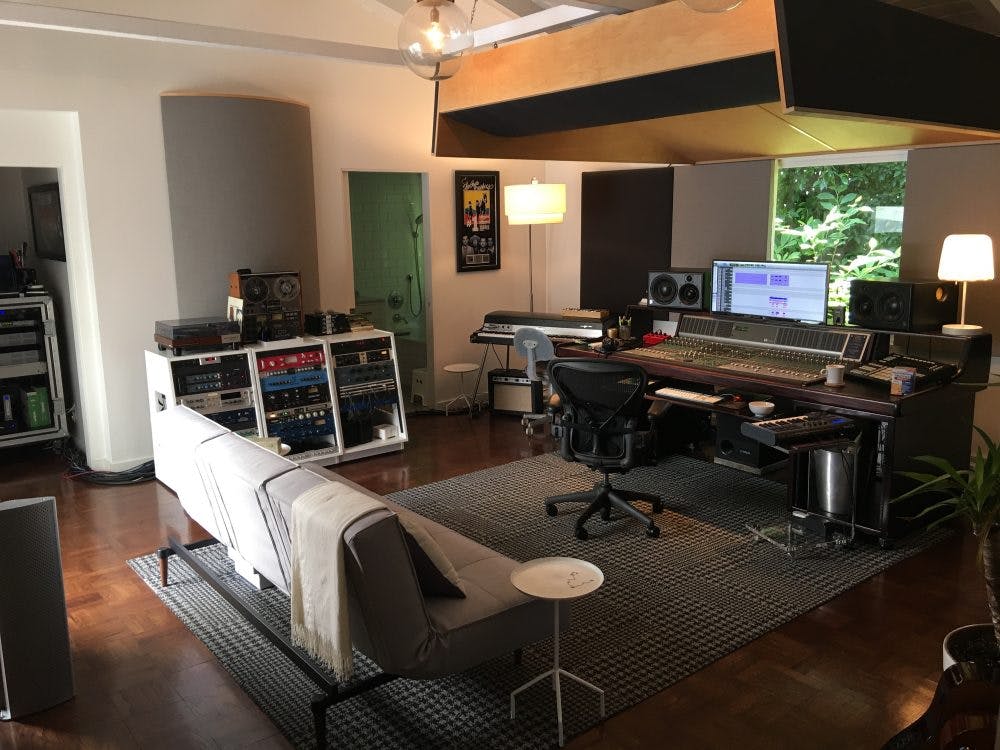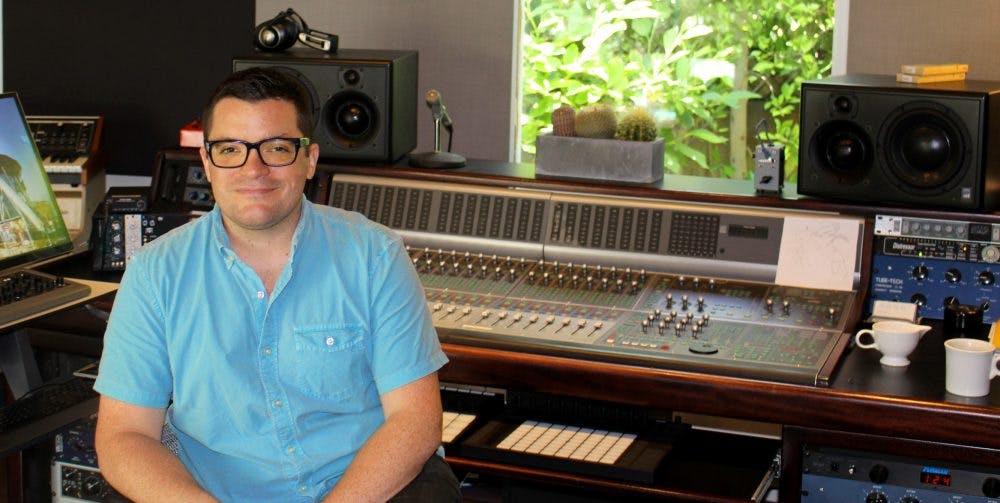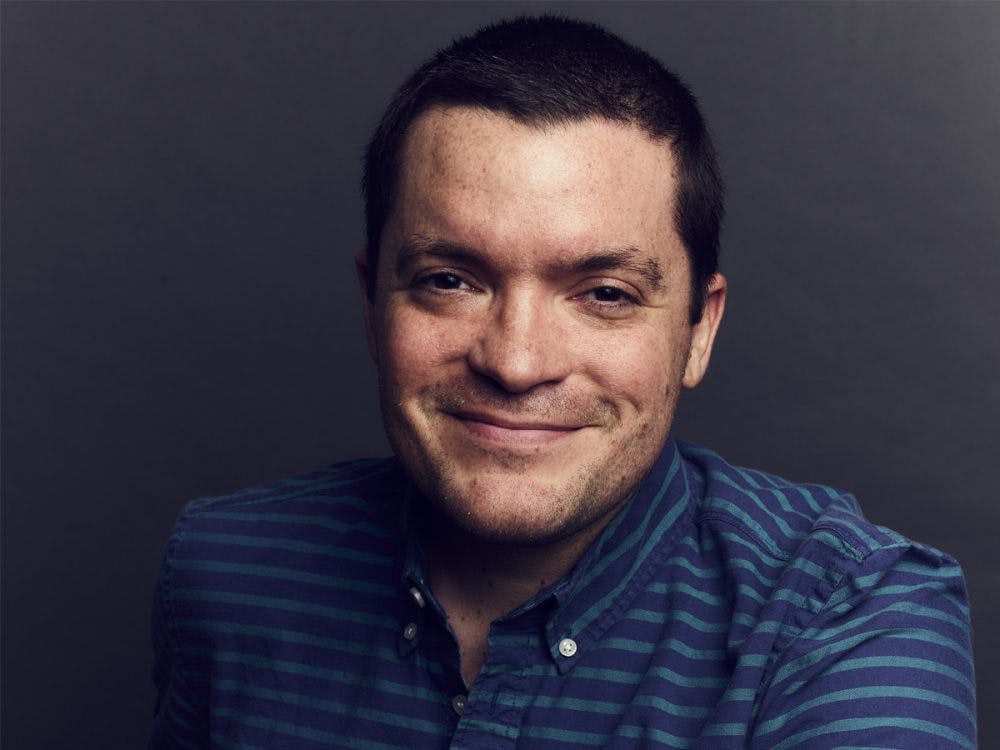I recently sat down with Dana Nielsen at the home he shares with his wife and daughter in West Los Angeles and spoke about his background and experiences engineering, mixing and producing some of the biggest artists of today, yesterday and tomorrow. Dana’s credits are truly dizzying, including: Adele, Rihanna, Smashing Pumpkins, The Avett Brothers, Kanye West, Neil Young, Red Hot Chili Peppers, Weezer, Bob Dylan, Black Sabbath, Justin Timberlake, Santana, System of a Down, Dee Snider, Neil Diamond, Slayer and more. Dana is a musician, singer, engineer, mixer and producer who may be best known for his projects under Rick Rubin’s supervision, but Dana has also amassed a serious list of credits as a producer, writer and musician for film and TV music.
Dana records out of many studios, including Rick Rubin’s Shangri-La Studio in Malibu, but returns to his home studio for all his mixes. His airy and comfortable studio centers around Pro Tools HDX, a 24-channel Avid D-Command, ATC SCM25A monitors and a handful of analog outboard pieces. Dana has calibrated his ATC monitors with Sonarworks 4 and uses the same ATC monitors at Shangri-La studios to ensure consistency during his tracking sessions. The following questions and answers came out of our conversation over some buzz-inducing iced coffee.
You started out as a jazz musician in the Midwest wound up as a producer and mixer in Los Angeles. How did this happen?
I grew up around Geneva and St. Charles, Illinois. My wife, Charissa, and I have known each other since 8th grade and have been performing together in bands and school ensembles since high school. She’s an amazing singer and vocal contractor for film, TV and albums. She actually put a group together and sang on the recent Smashing Pumpkins album I recorded and mixed, and has been performing with them live occasionally. So wild! She also got me into composing and mixing music for TV and ads. There’s a Jif peanut butter ad that just came out that features me and Charissa and our 7 year old daughter singing on a doo-wop track I wrote. We have a music-filled household, that’s for sure. Anyway, Charissa and I went to Loyola University in New Orleans, where I was a jazz saxophone major, and then we moved to L. A. in 2000. While I was at school, I got super involved in studio and electronic music classes and totally loved it. I eventually got keys to the school’s studio and started doing sessions there. The school had a state-of-the-art, for the time, Pro Tools Mix Plus system and the Waves Gold bundle of plugins. I realized then that I could get involved in a lot more music than might be traditionally applicable to just being a jazz saxophone player. I had broader tastes in music than just jazz and blues and I worked on productions for a lot of different musical styles.

When I moved to L.A. I started out working at the Hollywood Guitar Center and then Westlake Audio (in their sales department) configuring Pro Tools systems for all these insane clients, like David Foster. I met lots of people that way. I also had a local Music Connection magazine ad that I would run for producing tracks for singers and songwriters. Ultimately one of my first big breaks came through helping put a system together for Colin Hay from Men at Work and then I started working with John Hanlon (engineer/mixer for Neil Young, Jackson Browne, R.E.M.) and we still work together today. John would teach me the old school engineering ways and I would show him the modern stuff. We still continue to work that way today!
How did that work lead to working with Rick Rubin?
My first project at Rick’s old spot was as an assistant on a Jayhawks live record where John Hanlon needed an extra hand with Pro Tools, and I ended up getting to help him in tiny ways mixing on an analog console that had no automation. He would tell me things like “…in this verse move that fader here and turn off that EQ…” On that job I met Rick and his production assistant, Lindsay [Chase]. Eventually I started getting calls as a second engineer for Rick’s sessions, starting with Neil Diamond’s 12 Songs album. We did two albums with Neil at his studio [Archangel]. It was a fortunate and unorthodox route.
So how did you then make the jump from being an assistant engineer and Pro Tools tech to being a mixer on these huge projects?
You know, honestly, that 12 Songs album was the first project that I did with [Rick Rubin], Greg Fidelman and Andrew Scheps, who are amazing engineers, mixers and producers. I was second engineer and then there was a snafu on the release that had to do with some Sony anti-piracy issue and it botched the release. I had moved on to working on some other projects and Rick asked me to go back to [Neil Diamond’s] original raw takes for the 12 Songs album and and pick alternate takes with no extra overdubs for a new release that would be called 12 Songs Artist Cut. The raw tracking was how I remembered the record from the tracking sessions, and I made rough mixes so Rick could hear the original arrangements and I worked really hard on those rough mixes. I had been around Rick a lot, but this was the first time I had a chance to play music for Rick in his listening room, so it was really exciting. After listening to my rough mixes, Rick called Neil [Diamond] and said, “I think we have our guy…” I was like “Whaaaaat!” and he let me mix the record. He later asked me to mix Neil’s subsequent album, “Home Before Dark.” I also spent a lot of time editing productions for Rick, starting with System of a Down Mezmerize. During that period of time there were a lot of ups and down, where one day I was mixing and one day I was editing. But really, it was all “ups”…such an exciting time.
I remember on Justin Timberlake’s album we were tracking at Archangel studio—and I’m not sure how this came about—but I wound up asking Rick if he minds if I wrote some horn charts for some of Justin’s stuff and Rick was like “sure, knock yourself out.” I remember being really excited and feeling really cool about that. Sometimes, like on the new Avett Brothers record, I might add some stuff like keys or percussion—interesting small stuff like that. Being in the right place at the right time is key.
Do you feel like analog gear has a strong place for you or are you mostly working in-the-box?
I love recording and getting sounds and I get pretty intense during the go-down, getting the right sounds into Pro Tools. It’s fun at Shangri-La on the API board. I’ll use a bunch of Neve preamps and go line-in to the desk for tracking. On a full band session I might use some of the API pres or just use the console for bussing. I like to buss things together so the multitrack is not too overwhelming. Rick gives me free range to work how I see fit. As far as mixing, I’m mostly working in Pro Tools. For some records I’ll mix through my [Roll Music] Folcrom mixer into a pair of Neve pres for that sound. I don’t really sum through the Folcrom, but I use it to knock the signal down into the preamps. Certain projects, like the Santana mixes go through the [Neve] 31102s and that helps me get there faster. I drive the input hard and get some saturation and I can match the console sound that we heard during the tracking sessions.
There is a lot of mystery around working with Rick Rubin. How much time does Rick spend in the studio with you and the band during tracking sessions?
Rick is always there for the main tracking, always for vocals, for overall vibe and shape of the song, he’s there for tempo and key, always guiding the artist or band to find their most natural best performance—that’s his bread and butter, and what he’s a genius at. He might not be there once we’ve picked the take and the band wants to try some overdubs, but Rick is very detailed and I’m always taking notes about his take preferences. He always listens with a very open mind and gives great guidance.
Do you have any tricks that make your mix workflow more consistent or ways that you always work?
I have been working a little with a template for things like routing and having effects and inserts loaded and ready, but everything is bypassed when I start. Everything I do, whether I recorded it or not, I like to begin a mix by pulling all the faders down and start all over and rediscover the song. For example, what sounded good at the tracking studio may need to be reassessed for the mix. I have some typical bussing and parallel processing that I almost always use, but I don’t have any hard and fast rules.
How do you feel about reverb these days?
I’ve never been afraid of using reverb, I mean Rick has historically been super anti-reverb, haha, but that’s changed a lot over the last few years. Rick does like things dry as a bone sometimes for that intimate, connected and raw thing, but certainly not always. When I record, I mic pretty direct and close, but I also setup room mics to capture the room sound and ambience. I like stereo room mics so I can use either in mono or both. I’ll get a sound I’m confident with, but then I usually won’t monitor the room mics when Rick is around. Those ambience mics are a goldmine when I’m mixing, though. Even on acoustic guitars I’ll use a close mic and often a spaced pair a little bit back. I’m not sneaky about it— it’s just fun to have options later. Whatever’s best for the song.
Do you have your go-to mics for acoustic guitar and vocal?
Thinking back to the Avett Brother’s for example, on those guys I have 87’s for guitar and banjo, and I keep them in figure 8 and pointed sideways to keep any vocal bleed off the guitar mics. Vocally I have Seth on a [Telefunken] 251 and Scott on an [Neumann] M49.

What about your favorite plugins, like reverb?
That switches up a lot, except for [Avid] Reverb One. I’m always on a tear for developers to make AAX DSP plugins for zero latency during recording. I actually emailed Dave Derr and thanked him for creating his Arouser plugin in a DSP version, as well as a native version. I will gladly pay more for the DSP version because I need to run plugins during tracking with no latency. I love TL Space for the chambers and springs and to a lesser degree I’ll use ReVibe. I’ll use Altiverb for the other impulse response stuff. I’m big on the Avid 7-Band EQ, especially for cuts.
How did you get into using Sonarworks room calibration software?
There were a few things in the room that I was aware of, mostly a resonance in the room around 147 Hz. Certain songs, depending on the key would light up that frequency and I always have just mixed around the problem. For many years I just carved it out through trial and error, then I got the [Sonarworks] software and measured the room many times and you can see it clear as day—what I’ve always heard by ear. So it’s been really great not having to mix around the problem.
I know you love your ATC’s, but do you do any mixing in headphones?
I’ll definitely check my mixes and I love listening with headphones so I’ll spend time on ‘phones, especially with reverb details. I want people to enjoy listening on headphones. I’ve been on these Blue Sadie headphones for a while and I really like them a lot. My studio tracking headphones are the Sennheiser 280s. They are not too hyped, and you can wear them for a long time.
For more information on Dana and what he is up to, check him out:
Discography




